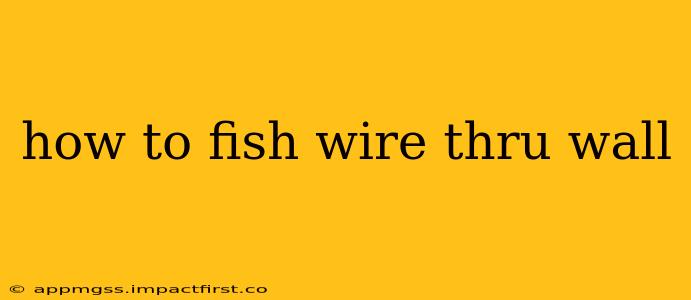Fishing wire through a wall can seem daunting, but with the right tools and techniques, it's a manageable DIY project. This comprehensive guide will walk you through the process, addressing common challenges and ensuring a successful outcome. Whether you're running new electrical wiring, installing network cables, or simply need to snake a wire through a wall cavity, this guide will equip you with the necessary knowledge.
What Tools Do I Need to Fish Wire Through a Wall?
Before you begin, gather the necessary tools. This will make the process much smoother and more efficient. You'll likely need:
- Fish tape or wire snake: This is the heart of the operation. Choose a tape or snake appropriate for the distance and the tightness of the space. Flexible options are best for navigating complex wall structures.
- Drill with appropriate drill bits: You may need to create access holes if you don't have existing ones. Consider using a smaller pilot hole to start and widening if needed.
- Safety glasses: Protect your eyes from debris or accidental injury.
- Stud finder: Avoid damaging structural elements by locating studs before drilling.
- Tape measure: Accurately measure distances to ensure you have enough wire snake and to determine access point locations.
- Wire or cable: The wire or cable you're actually running through the wall.
- Optional: Flexible magnet: Can be helpful for retrieving the fish tape or for attaching to the end of the wire to help guide it.
- Optional: Flashlight: Essential for inspecting dark wall cavities.
How Do I Find the Best Place to Drill a Hole?
Choosing the right location for your access hole is crucial for a successful wire fishing job. Consider these factors:
- Accessibility: Select a location that's easily accessible and allows for comfortable maneuvering of your tools.
- Stud avoidance: Use a stud finder to identify the location of wall studs. Avoid drilling into studs as they are structural supports.
- Existing holes: If possible, utilize existing holes, such as those left behind from previous electrical work or plumbing, to minimize drilling.
- Minimizing damage: The less you drill, the better. Plan your route carefully.
What if I Can’t Find the Other End of the Wall?
This is a common challenge. Here are some strategies to overcome it:
- Use a second access point: Drilling a hole at the opposite end of the wall can provide a better view and access to guide your fish tape.
- Utilize existing openings: Look for existing access points such as electrical outlets, junction boxes, or other openings near the target location.
- Use a helper: Having someone guide the fish tape from the other side can greatly improve the chances of success.
- Listen for the fish tape: Gently move the fish tape and listen carefully; you might be able to hear it as it scrapes against the wall.
How Do I Attach the Wire to the Fish Tape?
Securely attaching the wire to the fish tape is critical to avoid losing your wire within the wall. Several methods can be used:
- Tape: Use strong electrical tape to firmly attach the wire to the fish tape.
- Small zip tie: A small zip tie can offer a more secure connection, especially for thicker wires.
- Dedicated fishing tools: Some specialized fishing tools include clips or magnets specifically designed for attaching wires.
What are the Most Common Mistakes to Avoid When Fishing Wire?
- Forcing the fish tape: Avoid pushing the fish tape too forcefully, which can cause damage to the walls or break the tape.
- Not using lubrication: Lubricating the fish tape can help it move more smoothly and reduce friction.
- Ignoring safety: Always wear safety glasses and avoid drilling into electrical wiring or gas lines.
- Improper wire attachment: Ensure the wire is securely attached to the fish tape to avoid disconnection.
How Do I Know if My Wiring is Properly Installed After Fishing the Wire?
Once you've successfully fished your wire, it's crucial to ensure a secure and safe connection. If working with electrical wiring, consult a qualified electrician for proper installation and inspection to ensure code compliance and prevent electrical hazards.
By following these steps and utilizing the right techniques, you can successfully fish wire through a wall. Remember, patience and careful planning are key to a successful project. Remember to prioritize safety throughout the entire process.
